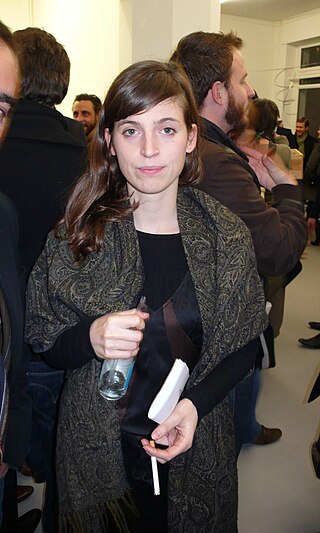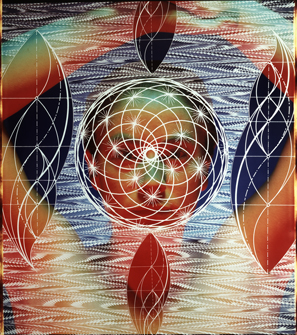
Mark Grotjahn is an American painter best known for abstract work and bold geometric paintings. Grotjahn lives and works in Los Angeles.
Jutta Koether is a German artist, musician and critic based in New York City and Berlin since the early 1990s.

Olive Cotton was a pioneering Australian modernist photographer of the 1930s and 1940s working in Sydney. Cotton became a national "name" with a retrospective and touring exhibition 50 years later in 1985. A book of her life and work, published by the National Library of Australia, came out in 1995. Cotton captured her childhood friend Max Dupain from the sidelines at photoshoots, e.g. "Fashion shot, Cronulla Sandhills, circa 1937" and made several portraits of him. Dupain was Cotton's first husband.
Wade Guyton is an American post-conceptual artist who among other things makes digital paintings on canvas using scanners and digital inkjet technology.
R. H. Quaytman is an American contemporary artist, best known for paintings on wood panels, using abstract and photographic elements in site-specific "Chapters", now numbering 35. Each chapter is guided by architectural, historical and social characteristics of the original site. Since 2008, her work has been collected by a number of modern art museums. She is also an educator and author based in Connecticut.

Katherine Bradford, née Houston, is an American artist based in New York City, known for figurative paintings, particularly of swimmers, that critics describe as simultaneously representational, abstract and metaphorical. She began her art career relatively late and has received her widest recognition in her seventies. Critic John Yau characterizes her work as independent of canon or genre dictates, open-ended in terms of process, and quirky in its humor and interior logic.

Barbara Ess was an American pinhole camera photographer, No Wave musician and Just Another Asshole editor. She taught photography at Bard College since 1997; who in 2024, along with the Schwartz family, has established an annual award to assist Bard College photography students in need called The Barbara Ess Fund for Artistic Expression in Photography.
Sara VanDerBeek, is an American artist who lives and works in New York City. She is known for photographing sculptures and three-dimensional still-life assemblages of her own making, some of which she destroys after the photos have been taken, as well as for exploring the depiction of women in art history particularly classical or ancient sculpture.
Liz Deschenes is an American contemporary artist and educator. Her work is situated between sculpture and image and engages with post-conceptual photography and Minimalism. Her work examines the fluidity of the medium of photography and expands on what constitutes the viewing of a photograph. Deschenes has stated that she seeks to "enable the viewer to see the inconstancy of the conditions of display, which are always at play but sometimes hard to see." Her practice is not bound to a single technology, method, process, or subject, but to the fundamental elements of photography, such as light, paper, chemistry, and time.
Rochelle Feinstein is a contemporary American visual artist who makes abstract paintings, prints, video, sculpture, and installations that explore language and contemporary culture. She was appointed professor in painting and printmaking at the Yale School of Art in 1994, where she also served as director of graduate studies, until becoming professor emerita in 2017.

Eileen Cowin is a Los Angeles–based artist known for photography, video and mixed-media installations that draw on the language of mass media and art history and explore the relationship between narrative, fiction and non-fiction, memory and experience. Associated with the 1970s Los Angeles experimental photography scene and the Pictures Generation artists, her work combines familiar human situations and carefully chosen gestures, expressions and props to create enigmatic images whose implied, open-ended stories viewers must complete. Cowin has exhibited in more than forty solo shows in the United States and abroad, including at the Los Angeles County Museum of Art (LACMA), Museum of Contemporary Photography, Armory Center for the Arts and Contemporary Arts Center. Her work is included in more than forty institutional collections, including LACMA, the J. Paul Getty Museum, Brooklyn Museum, Art Institute of Chicago, San Francisco Museum of Modern Art (SFMOMA), and Smithsonian American Art Museum. She has been recognized with awards and commissions from the National Endowment for the Arts, LACMA, the City of Los Angeles (COLA), Public Art Fund, and the Sundance and USA film festivals. New York Times critic Andy Grundberg wrote that her multi-image work "sets up a tension between the familiar and the mysterious, creating a climate of implied danger, sexual intrigue and violence" in which clues abound to intimate various narratives. Jody Zellen observed that Cowin "manipulates the conventions of photography, film, and video to tell a different kind of story—one that explores where truth and fiction merge, yet presents no conclusions. Cowin's work provokes."
Sam Lewitt is an American contemporary artist living and working in Berlin. Lewitt “has long engaged questions of reading and legibility, systems of graphic and readerly notation, and technologies of communication old and new.”
Erika Vogt is a sculptor, printmaker and video artist. She received her BFA from New York University and her MFA from California Institute of the Arts. She is represented at both Overduin & Co. in Los Angeles and Simone Subal Gallery in New York City.
Annette Kelm is a German contemporary artist and photographer who is particularly known as a conceptual artist. Kelm uses medium or large format cameras in her work, creating still life and portraits. She favours using analog photography methods in her work.

Pamela Rosenkranz is a Swiss multimedia artist who uses light and liquid to demonstrate her concepts along with performance, sculpture, painting, and installation art. Her work explores ideas and concepts of what it means to be human, its ideologies, emptiness and meaninglessness, as well as globalization and consumerism. She is represented by Karma International, Zurich / Los Angeles; Miguel Abreu Gallery, New York; and Sprüth Magers Berlin, London and Los Angeles.
Charles Mayton is a New York-based painter. His work combines painterly abstraction with the iconography of digital media. Mayton’s visual strategies of appropriation and détournement have been compared to the appropriation art of the Pictures Generation.
Miguel Abreu Gallery is a contemporary art gallery with two locations in New York City.

Ellen Carey is an American artist known for conceptual photography exploring non-traditional approaches involving process, exposure, and paper. Her work has ranged from painted and multiple-exposure, Polaroid 20 x 24, Neo-Geo self-portraits beginning in the late 1970s to cameraless, abstract photograms and minimal Polaroid images from the 1990s onward, which critics often compare to color-field painting. Carey's sixty one-person exhibitions have been presented at museums, such as the Amon Carter Museum of American Art, International Center of Photography (ICP) and Wadsworth Atheneum Museum of Art, alternative spaces such as Hallwalls and Real Art Ways, and many commercial galleries. Her work is in numerous museum collections, including those of the Metropolitan Museum of Art, Whitney Museum of American Art, Los Angeles County Museum of Art, Centre Pompidou, and Smithsonian American Art Museum. In 2019, she was named one of the Royal Photographic Society (London) "Hundred Heroines", recognizing leading women photographers worldwide. Los Angeles Times critic Leah Ollman describes her photography as "inventive, physically involving, process-oriented work" and her recent photograms as "performative sculptures enacted in the gestational space of the darkroom" whose pure hues, shadows and color shifts deliver "optical buzz and conceptual bang". New York Times critic William Zimmer wrote that her work "aspires to be nothing less than a reinvention, or at least a reconsideration, of the roots or the essence of photography." In addition to her art career, Carey has also been a longtime educator at the Hartford Art School and a writer and researcher on the history of photography.
Raha Raissnia is a contemporary artist based in New York City, known for her painting, drawing, filmmaking and performance art. Raissnia manipulates cinema's structural elements in loop installations and live performances. She often alters and tunes the mechanical parts of her film projectors, relying on her hand and playing them similarly to the way musicians play instruments.
Cinzia Ruggeri was an Italian designer and artist. She is known for her postmodern and surreal garments.






